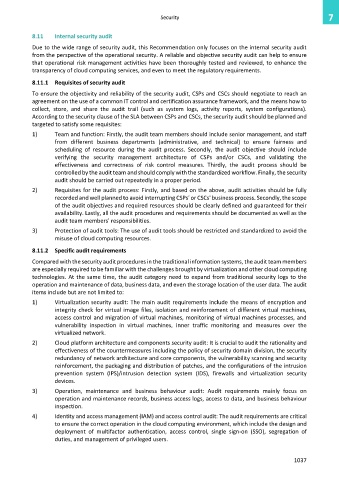Page 1045 - Cloud computing: From paradigm to operation
P. 1045
Security 7
8.11 Internal security audit
Due to the wide range of security audit, this Recommendation only focuses on the internal security audit
from the perspective of the operational security. A reliable and objective security audit can help to ensure
that operational risk management activities have been thoroughly tested and reviewed, to enhance the
transparency of cloud computing services, and even to meet the regulatory requirements.
8.11.1 Requisites of security audit
To ensure the objectivity and reliability of the security audit, CSPs and CSCs should negotiate to reach an
agreement on the use of a common IT control and certification assurance framework, and the means how to
collect, store, and share the audit trail (such as system logs, activity reports, system configurations).
According to the security clause of the SLA between CSPs and CSCs, the security audit should be planned and
targeted to satisfy some requisites:
1) Team and function: Firstly, the audit team members should include senior management, and staff
from different business departments (administrative, and technical) to ensure fairness and
scheduling of resource during the audit process. Secondly, the audit objective should include
verifying the security management architecture of CSPs and/or CSCs, and validating the
effectiveness and correctness of risk control measures. Thirdly, the audit process should be
controlled by the audit team and should comply with the standardized workflow. Finally, the security
audit should be carried out repeatedly in a proper period.
2) Requisites for the audit process: Firstly, and based on the above, audit activities should be fully
recorded and well planned to avoid interrupting CSPs' or CSCs' business process. Secondly, the scope
of the audit objectives and required resources should be clearly defined and guaranteed for their
availability. Lastly, all the audit procedures and requirements should be documented as well as the
audit team members' responsibilities.
3) Protection of audit tools: The use of audit tools should be restricted and standardized to avoid the
misuse of cloud computing resources.
8.11.2 Specific audit requirements
Compared with the security audit procedures in the traditional information systems, the audit team members
are especially required to be familiar with the challenges brought by virtualization and other cloud computing
technologies. At the same time, the audit category need to expand from traditional security logs to the
operation and maintenance of data, business data, and even the storage location of the user data. The audit
items include but are not limited to:
1) Virtualization security audit: The main audit requirements include the means of encryption and
integrity check for virtual image files, isolation and reinforcement of different virtual machines,
access control and migration of virtual machines, monitoring of virtual machines processes, and
vulnerability inspection in virtual machines, inner traffic monitoring and measures over the
virtualized network.
2) Cloud platform architecture and components security audit: It is crucial to audit the rationality and
effectiveness of the countermeasures including the policy of security domain division, the security
redundancy of network architecture and core components, the vulnerability scanning and security
reinforcement, the packaging and distribution of patches, and the configurations of the intrusion
prevention system (IPS)/intrusion detection system (IDS), firewalls and virtualization security
devices.
3) Operation, maintenance and business behaviour audit: Audit requirements mainly focus on
operation and maintenance records, business access logs, access to data, and business behaviour
inspection.
4) Identity and access management (IAM) and access control audit: The audit requirements are critical
to ensure the correct operation in the cloud computing environment, which include the design and
deployment of multifactor authentication, access control, single sign-on (SSO), segregation of
duties, and management of privileged users.
1037

